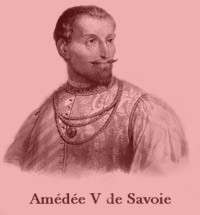Amadeus V, Count of Savoy
| Amadeus V, Count of Savoy | |
|---|---|
| Count of Savoy | |
 Amédée V de Savoie, from a lithography in Iconographia Saubadia (1832) | |
| Reign | 1285–1323 |
| Predecessor | Philip I |
| Successor | Edward |
| Born |
4 September 1249 Le Bourget-du-Lac |
| Died |
16 October 1323 Avignon |
| Noble family | Savoy |
| Spouse(s) |
Sybille of Bâgé Marie of Brabant |
| Issue | |
| Father | Thomas II of Savoy |
| Mother | Beatrice Fieschi |
Amadeus V (4 September 1249 – 16 October 1323), surnamed the Great for his wisdom and success as a ruler, was the Count of Savoy from 1285 to 1323. He established Chambéry as his seat. He was the son of Thomas II of Savoy and Beatrice Fieschi.[1]
Biography
Amadeus began life in the service of King Edward I of England, as a household knight, serving in the First Welsh War of 1277. During the Second Welsh War of 1282 he was in command of Edward’s forces at Chester that relieved the siege of Rhuddlan Castle.[2]
His childless paternal uncle, Count of Savoy, Philip I died in 1285.[3] Meanwhile earlier, in 1282, his elder brother of Thomas III of Piedmont, had accidentally died in 1282. Philip’s will charged his niece Eleanor of Provence and her son King Edward I of England with the inheritance of Savoy. Amadeus was awarded the County of Savoy, and in order to diminish family rivalry his younger brother Louis was awarded the new Barony of Vaud becoming Louis I of Vaud.[4]
Through his marriage to Sybilla, Countess of Bugey and Bresse, he was able to incorporate these Burgundian districts into his states. Later expansion saw his dominions further increased.
On 1 October 1285, Amadeus was declared protector of Geneva after negotiations with the Bishop of Geneva. The hereditary title belonged to Amadeus II, Count of Geneva who was in conflict with the Bishop.
In 1287 Amadeus besieged the castle of Ile in the Rhône near Geneva, and captured it after fourteen weeks.[5]

In 1295, Amadeus acquired the fortress at Chambéry from its previous owner Hugh of La Rochette. He brought Georges de Aquila, a student of Giotto from Florence, to his court. Georges decorated the castle with paintings, carved wood, and frescoes. He worked there for the Savoyards until he died in 1348.[6]
Among his successes was the Treaty of Annemasse which the Count of Geneva and the Dauphin of Viennois accepted subservient roles to him as his vassals. The treaty was the result of military victories over the both of them. In 1301, Amadeus also settled his dispute over control of Valais with the Roman Catholic Diocese of Sion.
His reign, however, also saw friction between the County of Savoy and the Duchy of Austria. He pursued an alliance with the Kingdom of France and received Maulévrier in Normandy as a result of initial good relations.
The eventual recovery of Lyon by the Kings of France alerted Amadeus to their expansionistic tendencies towards the regions by the Alps. He sought a powerful ally against potential hostility in Henry VII, Holy Roman Emperor. Henry was married to Margaret of Brabant, sister-in-law of Amadeus. The relation through marriage probably helped the alliance. Henry awarded Amadeus with the title of imperial vicar of Lombardy and at least titular claim over the Asti region. Henry also elevated Aosta and Chablais to duchies, though they remained a part of the realm of Savoy.[7]
In 1315, Amadeus assisted the Knights Hospitaller in the defense of Rhodes against the Turks.
Family and children
He first married Sybille de Baugé, daughter of Guy I Damas de Baugé, Baron of Couzan (c.1230-1269) and Dauphine de Lavieu,[8] and had eight children by her:
- Bonne of Savoy, married twice: 1) John I of Viennois, Dauphin of Viennois, 2) Hugh of Burgundy, Lord of Montbauson, the son of Hugh III, Count of Burgundy.[9]
- John of Savoy
- Beatrice of Savoy
- Edward of Savoy (d. 1329), succeeded his father, and married Blanche of Burgundy, daughter of Robert II, Duke of Burgundy.
- Eleonor of Savoy (d. after 1317), married three times: 1) William of Chalon, Count of Auxerre and Tonnerre, 2) Dreux IV of Mello, and 3) John I, Count of Forez.[9] Her daughter Marguerite de Mello married John II of Chalon-Arlay.
- Margaret of Savoy (d. 1349), married John I of Montferrat.[9]
- Agnes of Savoy (d. 1322), married William III of Geneva.[9] Their son was Amadeus III of Geneva.
- Aymon of Savoy (d. 1343), succeeded his brother Edward as Count of Savoy, and married Yolande of Montferrat,[9] the daughter of Theodore I, Marquess of Montferrat.
In 1297, he married, secondly, Marie of Brabant,[10] who was a daughter of John I, Duke of Brabant and Margaret of Flanders. Her maternal grandparents were Guy of Dampierre and his first wife, Matilda of Bethune. They had 4 children:
- Maria of Savoy, married Hugh, Baron of Faucigny, the son of Humbert I of Viennois.[9]
- Catherine of Savoy (d. 1336), married Leopold I, Duke of Austria and Styria.[9]
- Anna of Savoy (d. 1359), married Byzantine Emperor, Andronikos III Palaiologos.[9]
- Beatrice of Savoy (1310–1331), married, in 1327, Henry VI, Duke of Carinthia.[9]
Ancestry
| Ancestors of Amadeus V, Count of Savoy | |||||||||||||||||||||||||||||||||||||||||||||||||||||||||||||||||||||||||||||||||||||||||||||||||||||||||||||||||||||||||||||||||||||||||||||||||||||||||||||||||||||||||||||||||||||||||||||||||||||||||||||||||||||||||||||||||||||||||||||||||||||||||||||||||||||||||||||||||||||||||||||||||||||||||||||||||||||||||||||||||||||||||||||||||||||||||||||||||||||||||||||||||||||||||||||||||||||||||||||||||||||||||||||||||||||||||||||||||||||||||||||||||||||||||||||||||||||||||||||||||||||||||||||||||||||||||||||||||||||||||||||||||||||||||||||
|---|---|---|---|---|---|---|---|---|---|---|---|---|---|---|---|---|---|---|---|---|---|---|---|---|---|---|---|---|---|---|---|---|---|---|---|---|---|---|---|---|---|---|---|---|---|---|---|---|---|---|---|---|---|---|---|---|---|---|---|---|---|---|---|---|---|---|---|---|---|---|---|---|---|---|---|---|---|---|---|---|---|---|---|---|---|---|---|---|---|---|---|---|---|---|---|---|---|---|---|---|---|---|---|---|---|---|---|---|---|---|---|---|---|---|---|---|---|---|---|---|---|---|---|---|---|---|---|---|---|---|---|---|---|---|---|---|---|---|---|---|---|---|---|---|---|---|---|---|---|---|---|---|---|---|---|---|---|---|---|---|---|---|---|---|---|---|---|---|---|---|---|---|---|---|---|---|---|---|---|---|---|---|---|---|---|---|---|---|---|---|---|---|---|---|---|---|---|---|---|---|---|---|---|---|---|---|---|---|---|---|---|---|---|---|---|---|---|---|---|---|---|---|---|---|---|---|---|---|---|---|---|---|---|---|---|---|---|---|---|---|---|---|---|---|---|---|---|---|---|---|---|---|---|---|---|---|---|---|---|---|---|---|---|---|---|---|---|---|---|---|---|---|---|---|---|---|---|---|---|---|---|---|---|---|---|---|---|---|---|---|---|---|---|---|---|---|---|---|---|---|---|---|---|---|---|---|---|---|---|---|---|---|---|---|---|---|---|---|---|---|---|---|---|---|---|---|---|---|---|---|---|---|---|---|---|---|---|---|---|---|---|---|---|---|---|---|---|---|---|---|---|---|---|---|---|---|---|---|---|---|---|---|---|---|---|---|---|---|---|---|---|---|---|---|---|---|---|---|---|---|---|---|---|---|---|---|---|---|---|---|---|---|---|---|---|---|---|---|---|---|---|---|---|---|---|---|---|---|---|---|---|---|---|---|---|---|---|---|---|---|---|---|---|---|---|---|---|---|---|---|---|---|---|---|---|---|---|---|---|---|---|---|---|---|---|---|---|---|---|---|---|---|---|---|---|---|---|---|---|---|---|---|---|---|---|---|---|---|---|---|---|---|---|---|---|---|---|---|---|---|---|---|---|---|---|---|---|---|---|---|---|---|---|---|---|---|---|---|---|---|---|---|---|---|---|---|---|---|---|---|---|---|---|---|---|---|---|---|---|---|---|---|---|---|---|---|---|---|---|---|---|---|---|---|---|---|---|---|---|---|---|
| |||||||||||||||||||||||||||||||||||||||||||||||||||||||||||||||||||||||||||||||||||||||||||||||||||||||||||||||||||||||||||||||||||||||||||||||||||||||||||||||||||||||||||||||||||||||||||||||||||||||||||||||||||||||||||||||||||||||||||||||||||||||||||||||||||||||||||||||||||||||||||||||||||||||||||||||||||||||||||||||||||||||||||||||||||||||||||||||||||||||||||||||||||||||||||||||||||||||||||||||||||||||||||||||||||||||||||||||||||||||||||||||||||||||||||||||||||||||||||||||||||||||||||||||||||||||||||||||||||||||||||||||||||||||||||||
References
Sources
- Cox, Eugene L. (1967). The Green Count of Savoy. Princeton, New Jersey: Princeton University Press. LCCN 67-11030.
- Jobson, Adrian (2012). The First English Revolution: Simon de Montfort, Henry III and the Barons' War. Bloomsbury Academic.
- Taylor, A. J. (1953). "A Letter of Lewis of Savoy to Edward I". The English Historical Review. Oxford University Press. Vol. 68, No. 266 Jan.
External links
- His listing in "Medieval lands" by Charles Cawley. The project "involves extracting and analysing detailed information from primary sources, including contemporary chronicles, cartularies, necrologies and testaments."
Amadeus V Born: 4 September 1249 Died: 16 October 1323 | ||
| Regnal titles | ||
|---|---|---|
| Preceded by Philip I |
Count of Savoy 1285–1323 |
Succeeded by Edward |